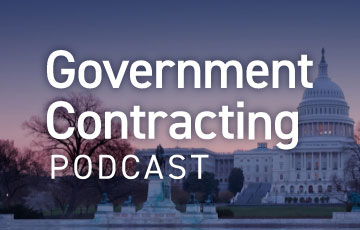Contributor: John Ford | Senior Consultant
Most of us have probably heard of the misconduct allegations made recently against high profile individuals in the media, entertainment industry, and Congress. Many of these allegations involve violations of Title VII of the Civil Rights Act of 1964 (“CRA”), while others may involve allegations of civil or criminal violations such as battery or even rape. While probably not as likely to make the headlines like the recent widely publicized cases, contractors can face many of these problems. This article will provide a high-level overview of some of the contracting issues contractors can face if their employees make such allegations.
The statutory basis for a sexual harassment complaint is found in 42 U.S.C. §2000e-2 which makes it an unlawful employment practice for an employer that employs at least 15 employees to discriminate against an employee or applicant for employment on the basis of sex. It should be noted that the CRA does not mention sexual orientation, although State Equal Employment Opportunity (“EEO”) laws may. The CRA gives the Federal Equal Opportunity Employment Commission (“EEOC”) the authority to enforce the provisions of the CRA. In this regard, the EEOC regulations implementing the sex discrimination provisions of the CRA can be found in 29 CFR 1604.11.
Sexual harassment has been held by the EEOC and courts to be a form of sex discrimination. The EEOC has provided the following summary description of what constitutes sexual harassment:
It is unlawful to harass a person (an applicant or employee) because of that person’s sex. Harassment can include “sexual harassment” or unwelcome sexual advances, requests for sexual favors, and other verbal or physical harassment of a sexual nature.
Harassment does not have to be of a sexual nature, however, and can include offensive remarks about a person’s sex. For example, it is illegal to harass a woman by making offensive comments about women in general.
Both victim and the harasser can be either a woman or a man, and the victim and harasser can be the same sex.
Although the law doesn’t prohibit simple teasing, offhand comments, or isolated incidents that are not very serious, harassment is illegal when it is so frequent or severe that it creates a hostile or offensive work environment or when it results in an adverse employment decision (such as the victim being fired or demoted).
The harasser can be the victim’s supervisor, a supervisor in another area, a co-worker, or someone who is not an employee of the employer, such as a client or customer.
A couple of points about this overview are worth noting. First, there are two types of sexual harassment. One is known as “quid pro quo” harassment, where submission to such harassment is made a condition of an employee’s employment. The other type is a hostile work environment, such as where demeaning or degrading comments about one’s gender are made and tolerated in the workplace.
The second point is that harassment may be done by someone other than an employee of the employer. This is a particularly thorny area for contractors who have employees who are working in government facilities with government personnel and are being harassed by government personnel. As an employer, the contractor has a legal duty under the CRA to protect its employees against such harassment. Therefore, the contractor should bring this issue up with the alleged harasser’s supervisor. Further, in some instances, the aggrieved employee may be able to bring an EEO complaint against the agency. The contractor should not reassign the employee without first discussing the matter with the employee and getting agreement from the employee.
The second problem in this area is where government employees, such as Defense Contract Audit Agency auditors, are frequent visitors or even resident at the contractor’s facility. If one of these government personnel is harassing a contractor employee, again the contractor should bring the matter up with the alleged harasser’s supervisor. If this does not solve the problem, the contractor can exercise its statutory duty to protect its employees from harassment by barring the government employee from the contractor’s facility.
Turning to contract-related matters, the primary remedy that is available to an employee who has been harassed is to receive backpay or monetary damages from the contractor. This implicates at least three cost principles and perhaps four and the EEO clause, Federal Acquisition Regulation (“FAR”) 52.222-26. The protections afforded employees under that clause are broader than those included in the CRA because the clause covers the same categories of protected status and adds a prohibition against discrimination based on sexual orientation or gender identity. Thus, a contractor can breach the contract without committing a CRA violation.
If a contractor has been found to have discriminated against an employee in a Federal or state proceeding, the contractor may be ordered to provide the employee with backpay. FAR 31.205-6(h) states that “[b]ackpay is unallowable except [p]ayments to employees resulting from underpaid work actually performed are allowable, if required by a negotiated settlement, order, or court decree.” Thus, not all backpay awards can be reimbursed under government contracts. Unless the backpay award is for work actually performed, it is an expressly unallowable cost.
The second cost principle that comes into play is FAR 31.205-33, which covers attorney fees. When an EEO complaint is filed with the EEOC, the EEOC usually investigates the complaint and attempts to resolve the matter through discussions with the employer and employee. If these discussions do not resolve the issue, the EEOC may bring an enforcement action in Federal district court against the employer or permit the employee to do so. If the employer prevails in the litigation and does not recover its attorney fees from the employee, which is discretionary with the District court, the employer should be able to recover its attorney fees if they comply with 31.205-33. If the contractor is found to have discriminated against the employee, the attorney fees incurred by the contractor would not be recoverable because the contractor would have violated the EEO clause. Thus, these costs would not be allowable under 31.201-2(a)(4) (a cost must comply with the terms of the contract to be allowable.)
The question remains as to whether the contractor would be able to recover its attorney fees and settlement expenses if it settles the complaint. This brings into play 31.205-47, the legal proceedings cost principle. In Geren v. Tecom, a 2009 Court of Appeals for the Federal Circuit decision, the court held that “[w]here the damages or penalties paid in the event of an adverse judgment are disallowed, the settlement cost is also unallowable unless the contractor can establish that the private Title VII plaintiff had very little likelihood of success on the merits.” Thus, if a contractor wishes to recover settlement costs and attorney fees, it must establish that the employee had little chance of succeeding on the merits of the complaint.
Finally, if the employee receives a favorable court judgment and can recover punitive damages, those damages would be an expressly unallowable cost under FAR 32.105-15, fines and penalties.



